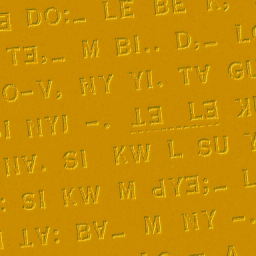Related Research Articles

Unicode is an information technology (IT) standard for the consistent encoding, representation, and handling of text expressed in most of the world's writing systems. The standard is maintained by the Unicode Consortium, and as of March 2020, there is a repertoire of 143,859 characters, with Unicode 13.0 covering 154 modern and historic scripts, as well as multiple symbol sets and emoji. The character repertoire of the Unicode Standard is synchronized with ISO/IEC 10646, and both are code-for-code identical.

The Fraser or Old Lisu script is an artificial script invented around 1915 by Sara Ba Thaw, a Karen preacher from Myanmar, and improved by the missionary James O. Fraser, to write the Lisu language. It is a single-case (unicameral) alphabet. It was also used for the Naxi language, e.g. the 1932 Naxi Gospel of Mark, and used in the Zaiwa or Atsi language e.g. the 1938 Atsi Gospel of Mark.
A Unicode block is one of several contiguous ranges of numeric character codes of the Unicode character set that are defined by the Unicode Consortium for administrative and documentation purposes. Typically, proposals such as the addition of new glyphs are discussed and evaluated by considering the relevant block or blocks as a whole.
Unicode has subscripted and superscripted versions of a number of characters including a full set of Arabic numerals. These characters allow any polynomial, chemical and certain other equations to be represented in plain text without using any form of markup like HTML or TeX.
As of Unicode version 13.0 Cyrillic script is encoded across several blocks, all in the BMP:
Miscellaneous Technical is a Unicode block ranging from U+2300 to U+23FF, which contains various common symbols which are related to and used in the various technical, programming language, and academic professions. For example:
Over a thousand characters from the Latin script are encoded in the Unicode Standard, grouped in several basic and extended Latin blocks. The extended ranges contain mainly precomposed letters plus diacritics that are equivalently encoded with combining diacritics, as well as some ligatures and distinct letters, used for example in the orthographies of various African languages and the Vietnamese alphabet. Latin Extended-C contains additions for Uighur and the Claudian letters. Latin Extended-D comprises characters that are mostly of interest to medievalists. Latin Extended-E mostly comprises characters used for German dialectology (Teuthonista).
In computing, a Unicode symbol is a Unicode character which is not part of a script used to write a natural language, but is nonetheless available for use as part of a text.
Lisu may refer to:
As of Unicode 13.0, the Arabic script is contained in the following blocks:
In the Unicode standard, a plane is a continuous group of 65,536 (216) code points. There are 17 planes, identified by the numbers 0 to 16, which corresponds with the possible values 00–1016 of the first two positions in six position hexadecimal format (U+hhhhhh). Plane 0 is the Basic Multilingual Plane (BMP), which contains most commonly used characters. The higher planes 1 through 16 are called "supplementary planes". The very last code point in Unicode is the last code point in plane 16, U+10FFFF. As of Unicode version 13.0, seven of the planes have assigned code points (characters), and five are named.
The Latin-1 Supplement is the second Unicode block in the Unicode standard. It encodes the upper range of ISO 8859-1: 80 (U+0080) - FF (U+00FF). Controls C1 (0080–009F) are not graphic. This block ranges from U+0080 to U+00FF, contains 128 characters and includes the C1 controls, Latin-1 punctuation and symbols, 30 pairs of majuscule and minuscule accented Latin characters and 2 mathematical operators.
Enclosed Alphanumerics is a Unicode block of typographical symbols of an alphanumeric within a circle, a bracket or other not-closed enclosure, or ending in a full stop.
CJK Symbols and Punctuation is a Unicode block containing symbols and punctuation used for writing the Chinese, Japanese and Korean languages.
The regional indicator symbols are a set of 26 alphabetic Unicode characters (A–Z) intended to be used to encode ISO 3166-1 alpha-2 two-letter country codes in a way that allows optional special treatment.
Enclosed Alphanumeric Supplement is a Unicode block consisting Latin alphabet characters and Arabic numerals enclosed in circles, ovals or boxes, used for a variety of purposes. It is encoded in the range U+1F100–U+1F1FF in the Supplementary Multilingual Plane.
Georgian is a Unicode block containing the Mkhedruli and Asomtavruli Georgian characters used to write Modern Georgian, Svan, and Mingrelian languages. Another lower case, Nuskhuri, is encoded in a separate Georgian Supplement block, which is used with the Asomtavruli to write the ecclesiastical Khutsuri Georgian script.
Lisu is a Unicode block containing characters of the Fraser alphabet, which is used to write the Lisu language. This alphabet consists of glyphs resembling capital letters in the basic Latin alphabet in their standard form and horizontally or vertically mirrored.
Symbols for Legacy Computing is a Unicode block containing graphic characters that were used for various home computers from the 1970s and 1980s and in Teletext broadcasting standards. It includes characters from the Amstrad CPC, MSX, Mattel Aquarius, RISC OS, MouseText, Atari ST, TRS-80 Color Computer, Oric, Texas Instruments TI-99/4A, TRS-80, Minitel, Teletext, ATASCII, PETSCII, ZX80, and ZX81 character sets, as well as semigraphics characters.
References
- ↑ "Unicode character database". The Unicode Standard. Retrieved 2020-03-11.
- ↑ "Enumerated Versions of The Unicode Standard". The Unicode Standard. Retrieved 2020-03-11.